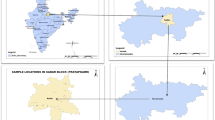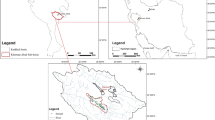Abstract
For irrigation purposes, groundwater quality should be regularly checked so that the danger of geochemical pollutants can be decreased using the suitable treatment procedure. As an outcome, the present work focused on shaping the suitability of groundwater collected from the Bankura sub-division in West Bengal, India, for irrigation purposes using several water quality indicators. To assess the groundwater quality, 59 samples were taken from various locations around the research region during the period between 2019 and 2020, and parameters such as pH, EC, TH, alkalinity (HCO3−), calcium (Ca +), magnesium (Mg + 2), sodium (Na +), chloride (Cl−), and potassium (K) were assessed. The permeability index (PI), magnesium ratio (MR), Kelley's Index (KI), and sodium percentage (Na%) were calculated using the aforementioned factors. Geostatistical modelling (Empirical Bayesian Kriging) has been used to evaluate the geographical distribution of groundwater quality parameters. For the majority of the index’s values, the exponential semivariogram model has been certified as the best-fitting model. Additionally, the water quality index (WQI) is used to represent total water quality in a single term and determine whether water is fit for human consumption or not. The study area's WQI values range from 14.6 to 46. 16.39% indicates good water, 20.54% indicates bad water, 51.17% indicates very poor water, and 11.90% indicates water unfit for agriculture. The current dataset revealed the use of water quality indices that could be useful to policymakers in terms of proper management, treatment, and long-term social progress.
Zusammenfassung
Für Bewässerungszwecke sollte die Grundwasserqualität regelmäßig überprüft werden, damit die Gefahr geochemischer Schadstoffe durch geeignete Aufbereitungsverfahren verringert werden kann. Infolgedessen konzentrierte sich die vorliegende Arbeit darauf, die Eignung des im Bankura-Untergebiet in Westbengalen, Indien, gesammelten Grundwassers für Bewässerungszwecke anhand verschiedener Wasserqualitätsindikatoren zu bestimmen. Zur Beurteilung der Grundwasserqualität wurden im Zeitraum zwischen 2019 und 2020 59 Proben an verschiedenen Orten im Forschungsgebiet entnommen und Parameter wie pH-Wert, EC, TH, Alkalität (HCO3-), Calcium (Ca+), Magnesium (Mg+) ermittelt 2) wurden Natrium (Na+), Chlorid (Cl-) und Kalium (K) bewertet. Der Permeabilitätsindex (PI), das Magnesiumverhältnis (MR), der Kelley-Index (KI) und der Natriumanteil (Na%) wurden unter Verwendung der oben genannten Faktoren berechnet. Geostatistische Modellierung (Empirical Bayesian Kriging) wurde verwendet, um die geografische Verteilung von Grundwasserqualitätsparametern zu bewerten. Für die Mehrzahl der Indexwerte wurde das exponentielle Semivariagramm-Modell als das am besten passende Modell zertifiziert. Darüber hinaus wird der Wasserqualitätsindex (WQI) verwendet, um die Gesamtwasserqualität in einem einzigen Begriff darzustellen und zu bestimmen, ob Wasser für den menschlichen Verzehr geeignet ist oder nicht. Die WQI-Werte des Untersuchungsgebiets liegen zwischen 14.6 und 46. 16.39 % weisen auf gutes Wasser hin, 20.54 % auf schlechtes Wasser, 51.17 % auf sehr schlechtes Wasser und 11.90 % auf Wasser, das für die Landwirtschaft ungeeignet ist. Der aktuelle Datensatz enthüllte die Verwendung von Wasserqualitätsindizes, die für politische Entscheidungsträger im Hinblick auf eine ordnungsgemäße Bewirtschaftung, Behandlung und langfristigen sozialen Fortschritt nützlich sein könnten.













Similar content being viewed by others
References
Ali SA, Ahmad A (2020) Analysing water-borne diseases susceptibility in Kolkata municipal corporation using WQI and GIS based kriging interpolation. Geo J 85:1151–1174
Aragüés R, Medina ET, Zribi W, Clavería I, ÁlvaroFuentes J, Faci J (2015) Soil salinization as a threat to the sustainability of deficit irrigation under present and expected climate change scenarios. Irrig Sci 33:67–79. https://doi.org/10.1007/s00271-014-0449-x
Ayers RS, Westcot DW (1985) Water quality for agriculture. FAO Irrigation and Drainage, Paper 29; Food and Agriculture Organization: Rome.
Banderi A, Sheikh MM, Hamdi H, Shomeli M, Gol ASD (2012) Water quality assessment of Amir Kabir sugarcane agro-industry with respect to agricultural and drinking views. J Environ Ecol 3(1):166–183
Bhuiyan MAH, Dampare SB, Islam MA, Suzuki S (2015) Source apportionment and pollution evaluation of heavy metals in water and sediments of Buriganga River, Bangladesh, using multivariate analysis and pollution evaluation indices. Environ Monit Assess 187:4075
Bhunia GS, Keshavarzi A, Shit PK et al (2018) Evaluation of groundwater quality and its suitability for drinking and irrigation using GIS and geostatistics techniques in semiarid region of Neyshabur. Iran Appl Water Sci 8:168. https://doi.org/10.1007/s13201-018-0795-6
BIS (1998) Drinking Water Specifications (Revised 2003). IS:10500, Bureau of Indian Standards, New Delhi.
Bodrud-Doza Md, Islam ARMT, Ahmeda F, Das S, Saha N, Rahman MS (2016) Characterization of groundwater quality using water evaluation indices, multivariate statistics and geo-statistics in central Bangladesh. Water Sci 30(1):19–40. https://doi.org/10.1016/j.wsj.2016.05.001
Das S, Gupta A, Ghosh S (2017) Exploring groundwater potential zones using MIF technique in semi-arid region: a case study of Hingoli district. Maharashtra Spat Inform Res 25(6):749–756. https://doi.org/10.1007/s41324-017-0144-0
Das M, Parveen T, Ghosh D, Alam J (2021) Assessing groundwater status and human perception in drought-prone areas: a case of Bankura-I and Bankura-II blocks, West Bengal (India). Environ Earth Sci 80(18):636. https://doi.org/10.1007/s12665-021-09909-8. Epub 2021 Sep 14. PMID: 34539928 ; PMCID: PMC8438654.
Deshpande SM, Aher KR (2012) Evaluation of groundwater quality and its suitability for drinking and agriculture use in parts of Vaijapur, District Aurangabad, MS, India. J Chem Sci 2:25–31
du Plessis A (2022) Persistent degradation: global water quality challenges and required actions. One Earth 5(2):129–131
FAO (1985) Water Quality Guidelines for Agriculture, Surface Irrigation and Drainage; FAO: Rome, Italy.
Gharbia AS, Gharbia SS, Abushbak T, Wafi H, Aish A, Zelenakova M, Pilla F (2016) Groundwater quality evaluation using GIS based geostatistical algorithms. J Geosci Environ Protection 4(2):89–103
Gidey A (2018) Geospatial distribution modeling and determining suitability of groundwater quality for irrigation purpose using geospatial methods and water quality index (WQI) in Northern Ethiopia. Appl Water Sci 8:82. https://doi.org/10.1007/s13201-018-0722-x
Gunaalan K, Ranagalage M, Gunarathna MHJP, Kumari MKN, Vithanage M, Saravanan S, Warnasuriya TWS (2018) Application of geospatial techniques for groundwater quality and availability assessment: A case study in Jaffna Peninsula. Sri Lanka Int J Geo-Inform 7:20. https://doi.org/10.3390/ijgi7010020
Khodapanah L, Sulaiman W, Khodapanah N (2009) Groundwater quality assessment for different purposes in Eshtehard District, Tehran. Iran Euro J Sci Res 36(4):543–553
Krishnamurthy NS, Chandra S, Dewashisk K (2007) Geophysical characterisation of hard rock aquifers. In: Ahmed S, Jayakumar S, Salih A (eds) Groundwater dynamics in hard rock aquifers. Springer, Netherlands, pp 64–86
Krivoruchko K, Gribov A (2014). Pragmatic Bayesian Kriging for Non-Stationary and Moderately NonGaussian Data. In: Pardo-Igúzquiza, E. et al. (Eds.), Mathematics of Planet Earth: Proceedings of the 15th Annual Conference of the International Association for Mathematical Geosciences. Springer Berlin Heidelberg, Berlin, Heidelberg 61–64. https://doi.org/10.1007/978-3-642-32408-6_15
Krivoruchko K, Gribov A (2019) Evaluation of empirical Bayesian kriging. Spatial Statistics 32:100368. https://doi.org/10.1016/j.spasta.2019.100368
Kundu R, Ara MH (2019) Irrigation water quality assessment of Chitra River, Southwest Bangladesh. J Geosci Environ Protect 7:175–191. https://doi.org/10.4236/gep.2019.74011
Lin L, Yang H, Xu X (2022) Effects of water pollution on human health and disease heterogeneity: a review. Front Environ Sci 10:880246. https://doi.org/10.3389/fenvs.2022.880246
Longley PA, Goodchild MF, Maguire DJ, Rhind DW (2005) Geographic Information Systems and Science; John Wiley and Sons: Hoboken. NJ, USA
Masoud AA (2014) Groundwater quality assessment of the shallow aquifers west of the Nile Delta (Egypt) using multivariate statistical and geostatistical techniques. J African Earth Sci 95:123–137
Milly PCD (1994) Climate, soil water storage, and the average annual water balance. Water Resour Res 30(7):2143–2156. https://doi.org/10.1029/94WR00586
Mirzaei R, Sakizadeh M (2016) Comparison of interpolation methods for the estimation of groundwater contamination in Andimeshk-Shush Plain, Southwest of Iran.—Environmental Science and Pollution Research 23(3): 2758–2769. https://doi.org/10.1007/s11356-015-5507-2
Mohan R, Singh AK, Tripathi JK, Chowdhary GC (2000) Hydrochemistry and quality assessment of ground water in Naini Industrial area, Allahabad district, Uttar Pradesh. J Geol Soc Ind 55:77–89
Molla MA, Saha N, Salam SA (2015) Rakib-uz-Zaman M (2015) Surface and groundwater quality assessment based on multivariate statistical techniques in the vicinity of Mohanpur. Bangladesh Int J Environ Health Eng 4:18. https://doi.org/10.4103/2277-9183.157717
Nag SK (1998) Morphometric analysis using remote sensing techniques in the Chaka sub-basin, Purulia district, West Bengal. J Indian Soc Remote Sens 26(1):69–76. https://doi.org/10.1007/BF03007341
Nag SK, Ghosh P (2013) Variation in groundwater levels and waterquality in Chhatna Block, Bankura District, West Bengal—AGIS approach. J Geol Soc India 81(2):261–280
Nag SK, Das S (2017) Assessment of groundwater quality from Bankura I and II Blocks, Bankura District, West Bengal, India. Appl Water Sci. https://doi.org/10.1007/s13201-017-0530-8.
Pillai G, Khan IA (2016) Assessment of groundwater suitability for drinking and irrigation purpose in the Dimbhe command area of River Ghod, Maharashtra, India. J Geosci Environ Protect 4:142–157. https://doi.org/10.4236/gep.2016.412011
Pritchard M, Mkandawire T, O’Neill JG (2008) Assessment of groundwater quality in shallow wells within the southern districts of Malawi. Phys Chem Earth 33:812–823
Rajmohan N, Al-Futaisi A, Jamrah A (2007) Evaluation of long-term groundwater level data in regular monitoring wells, Barka, Sultanate of Oman. Hydrol Process 2z:3367–3379
Ramesh R, Anbu M (1996) Chemical methods for environmental analysis: water and sediment. Macmillan Publishers, London
Ramesh K, Elango L (2012) Groundwater quality and its suitability for domestic and agricultural use in Tondiar river basin, Tamil Nadu, India. Environ Monit Assess 184:3887–3899
Ramesh BK, Velayutham PM, Vanitha S, Diagu J (2020) Analysis of surface water quality for irrigation in Padmanabhapuram fort (Kanyakumari District, Tamil Nadu) India. IOP Conf. Series: Materials Science and Engineering 872: 1219, https://doi.org/10.1088/1757-899X/872/1/012191
Roy S, Hazra S, Chanda A, Das S (2020) Assessment of groundwater potential zones using multi-criteria decision-making technique: a micro-level case study from red and lateritic zone (RLZ) of West Bengal. India Sustain Water Resour Manag 6(1):1–14. https://doi.org/10.1007/s40899-020-00373-z
Senoro DB, de Jesus KLM, Mendoza LC, Apostol EMD, Escalona KS, Chan EB (2022) Groundwater quality monitoring using in-situ measurements and hybrid machine learning with empirical Bayesian Kriging interpolation method. Appl Sci 12:132. https://doi.org/10.3390/app12010132
Srinivasamoorthy K, Chidambaram S, Vasanthavigar M (2008) Geochemistry of fluorides in groundwater: salem District, Tamil Nadu. India J Environ Hydrol 1:16–25
Suarez DL, Wood JD, Lesch SM (2006) Effect of SAR on water infiltration under a sequential rain-irrigation management system. Agric Water Manag 86:150–164
Sulieman MM, Ibrahim IS, Elfaki JT (2016) Genesis and classification of some soils of the river nile terraces: a case study of Khartoum North, Sudan. J Geosci Environ Protect 4:1–16. https://doi.org/10.4236/gep.2016.43001
Tiwari AK, Singh PK, Mahato MK (2014) GIS-based evaluation of water quality index of groundwater resources in west Bokaro Coalfield. India Curr World Environ 9(3):73–79
Todd DK, Mays LW (2004) Groundwater hydrology: John Wiley & Sons.
Vasanthavigar M, Srinivasamoorthy K, Vijayaragavan K, Rajiv Ganthi R, Chidambaram S, Sarama VS, Anandhan P, Manivannan R, Vasudevan S (2010) Application of water quality index for groundwater quality assessment: Thirumanimuttar SubBasin, Tamilnadu. India Environ Monit Assess 171(1–4):595–609
Webster R, Oliver M (2001) Geostatistics for environmental scientists. John Wiley & Sons Ltd, Chichester, p 271
Yao L, Huo Z, Feng S, Mao X, Kang S, Chen J, Xu J, Steenhuis TS (2014) Evaluation of spatial interpolation methods for groundwater level in an arid inland oasis, northwest China. Environ Earth Sci 71:1911
Zeilhofer P, Zeilhofer LVAC, Hardoim EL, De Lima ZM, Oliveira CS (2007) GIS applications for mapping and spatial modeling of urban-use water quality: a case study in district of Cuiabá, Mato Grosso, Brazil. Cad Saude Publica, Rio de Janeiro 23(4):875884
Zeng C, Liu Z, Zhao M, Yang R (2016) Hydrologically driven variations in the karst-related carbon sink fluxes: Insights from high-resolution monitoring of three karst catchments in Southwest China. J Hydrol 533:74–90. https://doi.org/10.1016/j.jhydrol.2015.11.049
Acknowledgements
The authors thank Central Ground Water Board, Government of India for providing publicly available groundwater data.
Author information
Authors and Affiliations
Corresponding author
Ethics declarations
Conflict of interest
There is no conflict of interest.
Rights and permissions
Springer Nature or its licensor (e.g. a society or other partner) holds exclusive rights to this article under a publishing agreement with the author(s) or other rightsholder(s); author self-archiving of the accepted manuscript version of this article is solely governed by the terms of such publishing agreement and applicable law.
About this article
Cite this article
Laskar, A., Bhunia, G.S. An Appraisal of Water Quality using Geostatistics: A Case Study in Bankura Sub-division, West Bengal (India). KN J. Cartogr. Geogr. Inf. 74, 81–102 (2024). https://doi.org/10.1007/s42489-023-00152-8
Received:
Accepted:
Published:
Issue Date:
DOI: https://doi.org/10.1007/s42489-023-00152-8




